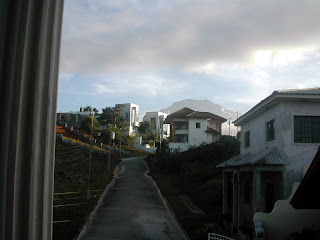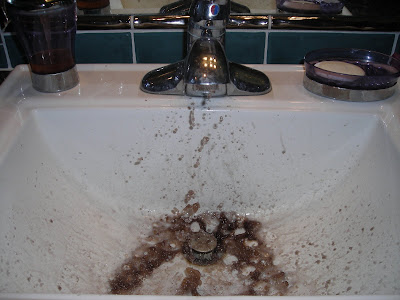 It is the custom in La Ceiba to surround homes with a high concrete wall which can be very depressing to look out upon. Especially so when the wall hasn't been painted yet like ours. It is definitely reminiscent of a prison setting.
It is the custom in La Ceiba to surround homes with a high concrete wall which can be very depressing to look out upon. Especially so when the wall hasn't been painted yet like ours. It is definitely reminiscent of a prison setting.Our west wall is the highest because we had it built with the adjoining property owner and he wanted a tall wall. We were so happy that he was going to share the cost of the wall (very rare to be so lucky) that we went along with his wishes. Most of the rest of our muro (fence) is low with decorative open ironwork.
 We don't have much space for planting on that side, so I designed a metal wall trellis for vines and had four of them made and installed on the west wall outside the windows so that we would have something pretty to look at.
We don't have much space for planting on that side, so I designed a metal wall trellis for vines and had four of them made and installed on the west wall outside the windows so that we would have something pretty to look at.I've tried starting some shade tolerant tropical vines from seeds for two of the windows but haven't had any luck with them germinating.
 For the wall outside the desayunador (breakfast area) and sala familiar (family room), we bought two bougainvilleas. They are called Napoleons here in Honduras. I'm not sure why. Bougainvillea was named after a Frenchman Bougainville, not Napoleon.
For the wall outside the desayunador (breakfast area) and sala familiar (family room), we bought two bougainvilleas. They are called Napoleons here in Honduras. I'm not sure why. Bougainvillea was named after a Frenchman Bougainville, not Napoleon. This bougainvillea has pink and orange flowers at the same time. It wouldn't have been my first choice, but all the vivero (nursery) had at the time was this one and a washed out lavender one that wasn't very pretty. This vine is covered with deadly thorns. I don't know the name of the variety so if you do, please tell me.
This bougainvillea has pink and orange flowers at the same time. It wouldn't have been my first choice, but all the vivero (nursery) had at the time was this one and a washed out lavender one that wasn't very pretty. This vine is covered with deadly thorns. I don't know the name of the variety so if you do, please tell me. I was afraid the vines wouldn't get enough light to bloom well since they are shaded by the house all morning and by the wall most of the afternoon, but they have finally taken off and have started blooming. It's such a joy to look out the window and see the flowers!
This is the bed below and if you look closely, you can see the Ramón and Conchita out doing their chicken work.










































 best bags
best bags worst bags
worst bags bad bags
bad bags better bags
better bags

 Welcome to my Blogicito —
Welcome to my Blogicito — 








